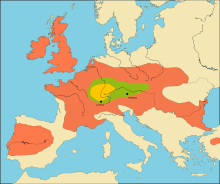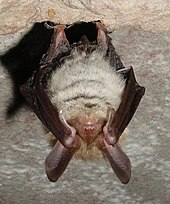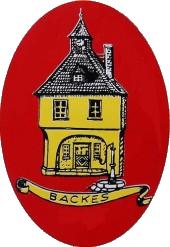Rohnstadt
|
Rohnstadt
Weilmünster market town
Coordinates: 50 ° 24 ′ 22 ″ N , 8 ° 21 ′ 37 ″ E
|
|
|---|---|
| Height : | 312 m above sea level NHN |
| Area : | 4.57 km² |
| Residents : | 257 (Jun 30, 2020) |
| Population density : | 56 inhabitants / km² |
| Incorporation : | December 31, 1970 |
| Postal code : | 35789 |
| Area code : | 06472 |
|
View of Rohnstadt
|
|
Rohnstadt is a district of the community of Weilmünster in the Limburg-Weilburg district in Central Hesse .
geography
location
Rohnstadt located in the eastern Hintertaunus , about three kilometers southwest of the core community, nestled in a high depression between the elevations Hofwald, Hühnerküppel , giant head piece in the conservation area of the Taunus Nature Park . The highest elevation in the district is the Hühnerküppel at 369 m above sea level. NN .
Neighboring towns are Laubuseschbach (west), Weilmünster (north) and Langenbach (south-east).
Flora and fauna
In the immediate vicinity you will find the typical meadow orchards and field hedges , which provide a habitat for numerous native species, as well as an area with heather-typical vegetation (wild heather, ferns, grasses, deciduous and coniferous trees, gorse), which is rare in the region. The small oak and hornbeam forests, typical of the Taunus, can also be found here on low-nutrient elevations. (like the stone )
history
Early history

Celtic fortifications ( ring walls ) on the giant head, the giant castle , and on the chicken trumpet indicate an older settlement in this area. Archaeological finds allow a classification in the late Hallstatt period or in the early and late La Tène period . A prehistoric long-distance route, the so-called Hessenstrasse (also called Hünerstrasse ), which connected the Rhineland with Kurhessen , previously took its course here.
Document mentions
The first documented mention of Rohnstadt comes from the year 1335. Richwin von Elkerhausen sold his nephew Hiltwin von Elkerhausen and his wife Christine his farm to Ramßhart (Rohnstadt).
Historical forms of names
In the obtained certificates Rohnstadt was conducted under the following place names mentioned (each with the year of reference):
|
|
Territorial reform
As part of the regional reform in Hesse , the former market town of Weilmünster in the Oberlahnkreis merged voluntarily on December 31, 1970 with the previously independent communities Aulenhausen, Dietenhausen, Ernsthausen, Laimbach, Langenbach, Laubuseschbach, Lützendorf, Möttau, Rohnstadt and Wolfenhausen to form the new large community of Weilmünster. Essershausen was added on December 31, 1971. For all twelve formerly independent municipalities, local districts with local advisory councils and local councilors were formed in accordance with the Hessian municipal code.
Territorial history and administration
The following list gives an overview of the territories in which Rohnstadt was located and the administrative units to which it was subordinate:
- before 1806 Holy Roman Empire, County / Principality of Nassau-Weilburg , Amt Weilmünster
- from 1806: Duchy of Nassau , Weilburg office
- from 1816: German Confederation , Duchy of Nassau, Weilburg office
- from 1849: German Confederation, Duchy of Nassau, Hadamar District Office
- from 1854: German Confederation, Duchy of Nassau, Weilburg office
- from 1867: North German Confederation , Kingdom of Prussia , Province of Hessen-Nassau , Administrative Region of Wiesbaden , Oberlahnkreis
- from 1871: German Empire , Kingdom of Prussia, Province of Hessen-Nassau, administrative district of Wiesbaden, Oberlahnkreis
- from 1918: German Empire, Free State of Prussia , Province of Hessen-Nassau, Administrative Region of Wiesbaden, Oberlahnkreis
- from 1944: German Empire, Free State of Prussia, Nassau Province , Oberlahnkreis
- from 1945: American zone of occupation , Greater Hesse , Wiesbaden district, Oberlahn district
- from 1949: Federal Republic of Germany , State of Hesse , Wiesbaden district, Oberlahnkreis
- from 1968: Federal Republic of Germany, State of Hesse, administrative district Darmstadt , Oberlahnkreis
- on December 31, 1970 Rohnstadt was incorporated as a district of the newly formed community of Weilmünster.
- from 1974: Federal Republic of Germany, State of Hesse, administrative district Darmstadt, district Limburg-Weilburg
- from 1981: Federal Republic of Germany, State of Hesse, Gießen district, Limburg-Weilburg district
Structural development
With the territorial reform , which the residents described as incorporation with a negative undertone, the formerly independent municipality of Rohnstadt in what was then Oberlahnkreis became part of the greater Weilmünster municipality on July 1, 1971.
After the development of the place out of its narrow (local) core area into the new development areas Bürgerhausstraße (Gartenstraße), Heidestraße and currently Fichtenweg , as in many village structures, due to the demographic change and the growing demands on living space, more and more houses in the old one The town center is vacant and, due to the structural substance (small plots of land, adjacent buildings, small living space areas, etc.) can hardly be conveyed to new owners. The number of allotments on the outskirts, which used to be numerous, is also steadily decreasing. In the past, these gardens were used by many households to provide additional food.
In order to counteract the trend of town center dying, the EU, the federal government, the state and local authorities have launched numerous funding programs, such as the village renewal program, as a control tool.
Former railway line
On May 15, 1892, the Weilmünster – Rohnstadt (Spitzmühle stop) –Laubuseschbach line was opened. The route was mainly used to transport goods, especially the mined iron ore. Passenger traffic, most recently with railcars of series 795 , was completed 1955th In 1968 the line was completely shut down and dismantled. Today there is a walking and cycling path here.
electrification
Preparations for planning the electrical supply were interrupted in 1914 when the First World War broke out. The electrical network could not be put into operation until 1921. The cost to the community was 109,083 Reichsmarks . The operator was initially the Buderus factory in Wetzlar .
Water supply
Around 1921, too, the central water supply was ensured through the construction of a collecting shaft, pumping station and elevated tank . The pump type was a so-called Lambach pump , double-acting horizontal type, manufactured in 1921 by the Wilhelm Lambach company from Marienheide in the Rhineland. Purely mechanically, 2/3 of the amount of water pumped 1/3 of water into the elevated tank. The daily output was approx. 30 m 3 . The mechanics had to be serviced / lubricated regularly. From 1948 an electric pump was also used. In 1964 a new deep well was put into operation, which replaced the old pump system. The pump is now on display in the village square.
Street names in Rohnstadt
- Schultheißenstrasse (before 1972 Hauptstrasse)
- Langenbacher Strasse
- Bodenweg
- Heidestrasse
- Rauscheweg (before 1972 Bergstrasse)
- Bürgerhausstraße (before 1972 Gartenstraße)
- Fichtenweg (current development area)
Mining history
Mehlbach mine
The oldest mine in the Oberlahn area, the silver, copper and lead mine Grube Mehlbach , is mentioned in a document from 1495. The original mine was called Smytgin (Schmidtchen / Schmiedchen). The document from Count Ludwig von Nassau-Saarbrücken speaks among others Hans von Dörnberg ( court master of Landgrave Wilhelm III), Parakeet von Berlepsch ( 5th Chamberlain of Hesse ) and the printer from Mainz, Peter von Gernsheim , as well as Werner Lesch ( hen steward of Gleiberg and Schreiber), Eberhart (Ebert) Stommel ( Vogt zu Gleiberg) the right to extract step ores . Eberhart Stommel and Eberhard Rübsamen von Merenberg served as guardian of the then young Count until 1490 . The majority of the listed persons are 5 days before the issuance of the certificate on the list of participants of the important Worms Reichstag as court servants of Landgrave Wilhelm III. listed.
This mine, located in the Rohnstadt district, probably had its greatest yield only in the years after 1750. The success was so great that it was demonstrated by the minting of three so-called yield coins. The Mehlbacher guilders , half thalers and thalers are now numismatic rarities. Several hundred miners earned their daily bread here. A school was even set up for the children. In addition to the Rohnstadt school, the Rohnstadt teacher also had to teach the children in this branch. In 1902 the mine was finally shut down and the entrances filled.
- Classified minerals from the Mehlbach mine
Riesenburg Pit
The Riesenburg Roteisenstein mine was partially mined using opencast mining. A cable car ran from here to the Guntersau loading station near Weilburg, 12 km away . After 1925 operations were also stopped here.
Slate mining
The slate mining was operated in the local district in numerous tunnels and mines. Slate mining was stopped in 1910. Cheap slate from other pits made further mining unprofitable. The entrances to the abandoned tunnels were closed with bat protective grids in the late 1980s to protect rare bat species.
The following species have been spotted: Bechstein's bat ( Myotis bechsteinii), water bat ( Myotis daubentonii), great mouse- eared bat ( Myotis myotis), pipistrelle (Pipistrellus pipistrellus).
population
structure
The agriculture and mining (slate, ore) were for centuries the only chance in place. Today, like many other places in the neighborhood, Rohnstadt has developed into a commuter village . The proximity to the Rhein-Main area , which there offered work and income opportunities and the comparatively low building costs led but not, as in closer to the metropolitan area , located communities for so-called urban sprawl ( suburbanization ).
The town of Rohnstadt is located a little outside the so-called fat belt of the Rhine-Main area, but still benefits economically from it and was able to largely preserve its natural and culturally grown character without being exposed to the negative effects of a suburban area. Since 1934, the Rohnstadt volunteer fire brigade (from January 9, 1999 with youth fire brigade ) has provided fire protection and general help in this area.
Population development
Occupied population figures are:
| • 1630: | 12 households |
| Rohnstadt: Population from 1825 to 2020 | ||||
|---|---|---|---|---|
| year | Residents | |||
| 1825 | 169 | |||
| 1834 | 199 | |||
| 1840 | 201 | |||
| 1846 | 214 | |||
| 1852 | 221 | |||
| 1858 | 225 | |||
| 1864 | 224 | |||
| 1871 | 215 | |||
| 1875 | 231 | |||
| 1885 | 299 | |||
| 1895 | 265 | |||
| 1905 | 258 | |||
| 1910 | 233 | |||
| 1925 | 246 | |||
| 1939 | 205 | |||
| 1946 | 312 | |||
| 1950 | 289 | |||
| 1956 | 239 | |||
| 1961 | 244 | |||
| 1967 | 226 | |||
| 1970 | 257 | |||
| 1987 | 276 | |||
| 1993 | 303 | |||
| 1996 | 306 | |||
| 2001 | 303 | |||
| 2005 | 292 | |||
| 2010 | 286 | |||
| 2011 | 282 | |||
| 2015 | 257 | |||
| 2020 | 257 | |||
| Data source: Historical municipality register for Hesse: The population of the municipalities from 1834 to 1967. Wiesbaden: Hessisches Statistisches Landesamt, 1968. Further sources:; 2011 census | ||||
Religious affiliation
Source: Historical local dictionary
| • 1885: | 288 Protestant (= 96.32%), 11 Catholic (= 3.68%) residents |
| • 1961: | 196 Protestant (= 80.33%), 48 Catholic (= 19.67%) residents |
politics
mayor
|
|
Mayor
- Richard Lommel: 1970-1987
- Otto Krämer: 1987-2006
- Wolfgang Lommel 2006–2016
Local advisory board
The Rohnstadt local council consists of five voting members. After the local elections in Hesse in 2016 , the mayor is Martin Heil.
Culture and sights
societies
- Volunteer Fire Brigade Rohnstadt e. V., founded 1934 (since January 9, 1999 with the youth fire brigade and since 1984 with the singer group Roter Hahn )
- History and local history association Rohnstadt e. V., founded 1985
- Sportelf Rohnstadt 1980 e. V.
- Evangelical women's group
- Gesangverein Liederkranz 1878 e. V.
Buildings
For the listed cultural monuments of the place see the list of cultural monuments in Rohnstadt .
The church
In 1821 a chapel was built on the Rohnstädter Friedhof. At that time it cost 158 guilders and 20 kroner . The money came from the Weilburg Walpurgis pen . The Evangelical Luther Church was inaugurated in 1953. In 1988, the church received a ring with two bells through a donation campaign by the ev. Women's group.
The bakery
The Rohnstädter Backhaus, known in the village of Backes , is the landmark of Rohnstadt. It was built in 1927. Until 1970, the Rohnstadt municipal administration (town hall) was housed on the upper floor. The actual bakery with its natural stone oven is located on the ground floor . Bread (the so-called baking bread) and sheet cakes etc. are still baked there today. The Rohnstädter Heimatstube is located in the Backes . This village museum was set up by the History and Local History Association in 1986, making it the first permanent museum facility in the municipality. Numerous exhibits from earlier village life are shown there in a permanent exhibition. The house is a listed building.
Village community center
In 1972 the village community center was inaugurated. It was planned and prepared during the time of local self-government.
Youth center
At Langenbacher Strasse 10, an empty half-timbered house was made available to the village youth. The house is managed by the youngsters themselves.
Former village school
The first school in Rohnstadt was established around 1720. The community of Rohnstadt had to continue to contribute to the maintenance of the Weilmünster school until 1817. In 1836 a new school was built. The construction cost 2968 guilders. In 1900 a school well was dug and fitted with a pump. In 1908 a school sports field was laid out on the Rausche. The former village school taught until 1970. The building now serves as a residential building.
Fire station
A first syringe house was built in 1842. It cost 284 guilders and 86 kroner. In 1952, the old fire pond was converted into a modern fire water cistern and a new fire station was built above it .
Infrastructure
Since 1934, the Rohnstadt volunteer fire brigade (since January 9, 1999 with the youth fire brigade) has provided fire protection and general help in this area.
literature
- 1495 April 30th April 1495, Ludwig von Nassau-Saarbrücken lends a mine to Hans von Dörnberg. Regest no. 8659. Regest of the Landgraves of Hesse. (As of January 25, 2005). In: Landesgeschichtliches Informationssystem Hessen (LAGIS).
- Rohnstädter Chronik, begun in 1911 by Mayor Friedrich Zwingel
- Old streets in the Taunus
- Becker, history of mining in the Weilmünster office
- FA Schmidt, Rohnstadt-Ramshart, in Nassauische Annalen, Wiesbaden 1937
- Statistical information from the community of Weilmünster
- Literature about Rohnstadt in the Hessian Bibliography
Web links
- Rohnstadt district. In: website. Weilmünster community
- Rohnstadt. Local history, information. History and Heimatverein Rohnstadt eV
- Rohnstadt, Limburg-Weilburg district. Historical local dictionary for Hessen. In: Landesgeschichtliches Informationssystem Hessen (LAGIS).
Individual evidence
- ↑ a b c d Rohnstadt, Limburg-Weilburg district. Historical local dictionary for Hessen. (As of May 8, 2018). In: Landesgeschichtliches Informationssystem Hessen (LAGIS).
- ↑ a b Development of the population in the market town of Weilmünster. In: website. Weilmünster community, accessed August 2020 .
- ↑ Hochtaunus Nature Park ( Memento from October 12, 2007 in the Internet Archive ), accessed in August 2018.
- ↑ a b c Rohnstadt district. In: website. Weilmünster community, accessed August 2020 .
- ↑ Amalgamation of communities to form the community "Weilmünster", Oberlahnkreis on January 6, 1971 . In: The Hessian Minister of the Interior (ed.): State Gazette for the State of Hesse. 1971 No. 4 , p. 141 , point 170 ( online at the information system of the Hessian state parliament [PDF; 6.3 MB ]).
- ^ Federal Statistical Office (ed.): Historical municipality directory for the Federal Republic of Germany. Name, border and key number changes in municipalities, counties and administrative districts from May 27, 1970 to December 31, 1982 . W. Kohlhammer, Stuttgart / Mainz 1983, ISBN 3-17-003263-1 , p. 373 .
- ↑ main statute. (PDF; 51 kB) § 6. In: Website. Weilmünster community, accessed March 2020 .
- ^ Michael Rademacher: German administrative history from the unification of the empire in 1871 to the reunification in 1990. State of Hesse. (Online material for the dissertation, Osnabrück 2006).
- ↑ Selected data on population and households on May 9, 2011 in the Hessian municipalities and parts of the municipality. (PDF; 1 MB) In: 2011 Census . Hessian State Statistical Office
- ^ Community Weilmünster: Rohnstadt local advisory board , accessed in January 2017.
- ↑ State Office for Monument Preservation Hesse (ed.): Altes Rat- und Backhaus In: DenkXweb, online edition of cultural monuments in Hesse





